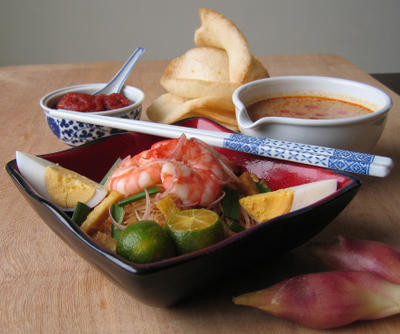IMBB #17: Tempest in a Teacup
 Oolong Tea Eggs One of my favourite ways of enjoying hard-cooked eggs, these beautifully marbled orbs look stunning when piled into a bowl, like so many exotic objets d'art. Their extraordinary appearance is acquired by steeping hard-cooked eggs - gently tapped with a heavy spoon to create a fine web of hairline cracks without actually removing any shell - in a barely trembling hot bath flavoured with loose tea leaves, soy sauce, star anise and cinnamon for several hours. I used Tie Guan Yin, the oolong tea named after the Iron Goddess of Mercy that's beloved for its delicate, orchid-like perfume. Off heat, the eggs are left to sit in the aromatic infusion, which further develops their flavour and mottled patina. I gingerly peel the eggshells off after a 12-hour soak - you could leave them for an even longer period if a deeper colour is desired - and serve them with roasted Sichuan pepper-salt.
Oolong Tea Eggs One of my favourite ways of enjoying hard-cooked eggs, these beautifully marbled orbs look stunning when piled into a bowl, like so many exotic objets d'art. Their extraordinary appearance is acquired by steeping hard-cooked eggs - gently tapped with a heavy spoon to create a fine web of hairline cracks without actually removing any shell - in a barely trembling hot bath flavoured with loose tea leaves, soy sauce, star anise and cinnamon for several hours. I used Tie Guan Yin, the oolong tea named after the Iron Goddess of Mercy that's beloved for its delicate, orchid-like perfume. Off heat, the eggs are left to sit in the aromatic infusion, which further develops their flavour and mottled patina. I gingerly peel the eggshells off after a 12-hour soak - you could leave them for an even longer period if a deeper colour is desired - and serve them with roasted Sichuan pepper-salt. Roast Tiger Prawns with White Tea Oil & Spiced Tea Salt This is based on a recipe from Tetsuya Wakuda's book. Large tiger prawns, beheaded and de-veined, are split lengthwise and seasoned with sea salt, freshly ground black pepper and tea - I used silvery needles of the white tea known as Pai Mu Dan (White Peony), grinding the tea to a fine dust with a spice mill. The prawns are roasted in a very hot oven for a couple of minutes, emerging succulent and juicy, and garnished with shreds of toasted nori. Delicious as they are, I couldn't resist serving them with a spiced salt not unlike the Japanese goma shio condiment. Making it was as simple as stirring together some fine sea salt with pinches of aonori (fine nori seaweed flakes), sansho (the ground spice made from the prickly ash pod), crushed dried red chillies, toasted black sesame, and last but not least, ground white tea.
Roast Tiger Prawns with White Tea Oil & Spiced Tea Salt This is based on a recipe from Tetsuya Wakuda's book. Large tiger prawns, beheaded and de-veined, are split lengthwise and seasoned with sea salt, freshly ground black pepper and tea - I used silvery needles of the white tea known as Pai Mu Dan (White Peony), grinding the tea to a fine dust with a spice mill. The prawns are roasted in a very hot oven for a couple of minutes, emerging succulent and juicy, and garnished with shreds of toasted nori. Delicious as they are, I couldn't resist serving them with a spiced salt not unlike the Japanese goma shio condiment. Making it was as simple as stirring together some fine sea salt with pinches of aonori (fine nori seaweed flakes), sansho (the ground spice made from the prickly ash pod), crushed dried red chillies, toasted black sesame, and last but not least, ground white tea.
 Jasmine Tea Smoked Poussin Lucid and highly detailed instructions for smoking all manner of poultry using equipment no fancier than an old battered wok can be found in both of Barbara Tropp's wonderful books, the China Moon Cookbook and The Modern Art of Chinese Cooking. I used several poussin, each of which makes for a perfectly-sized individual serving, providing every diner with an ideal package of skin and flesh to chew and bone to gnaw. The baby birds are thoroughly massaged with roasted Sichuan pepper-salt and tangerine peel, stuffed with crushed scallions and ginger, and left to marinate overnight before being steamed till partially cooked. They are then smoked over a mixture made up of equal parts tea leaves, brown sugar and raw rice. Ring the changes with your choice of tea and additional spices to flavour the smoke - I added Sichuan peppercorns, cinnamon, tangerine peel, star anise and cloves to the basic smoking mixture, and used large-leaf semi-fermented jasmine tea, which made for plumes of smoke with a heady incense-like redolence. I pull the plump poussin out of the wok when they've turned a rich amber hue - colouring is a good gauge of degree of flavour intensity when smoking. If you're after only the faintest whiff of smoke, pull them out when they're pale gold. If you like it pungent, wait till they're a deep mahogany. Enhance their lacquered sheen with a light glossing of fragrant sesame oil and devour warm, tepid, or best of all, cold. Ethereal is the only word to describe the experience of sensuously perfumed skin and melt-in-the-mouth fat melding into silken tender flesh with each bite.
Jasmine Tea Smoked Poussin Lucid and highly detailed instructions for smoking all manner of poultry using equipment no fancier than an old battered wok can be found in both of Barbara Tropp's wonderful books, the China Moon Cookbook and The Modern Art of Chinese Cooking. I used several poussin, each of which makes for a perfectly-sized individual serving, providing every diner with an ideal package of skin and flesh to chew and bone to gnaw. The baby birds are thoroughly massaged with roasted Sichuan pepper-salt and tangerine peel, stuffed with crushed scallions and ginger, and left to marinate overnight before being steamed till partially cooked. They are then smoked over a mixture made up of equal parts tea leaves, brown sugar and raw rice. Ring the changes with your choice of tea and additional spices to flavour the smoke - I added Sichuan peppercorns, cinnamon, tangerine peel, star anise and cloves to the basic smoking mixture, and used large-leaf semi-fermented jasmine tea, which made for plumes of smoke with a heady incense-like redolence. I pull the plump poussin out of the wok when they've turned a rich amber hue - colouring is a good gauge of degree of flavour intensity when smoking. If you're after only the faintest whiff of smoke, pull them out when they're pale gold. If you like it pungent, wait till they're a deep mahogany. Enhance their lacquered sheen with a light glossing of fragrant sesame oil and devour warm, tepid, or best of all, cold. Ethereal is the only word to describe the experience of sensuously perfumed skin and melt-in-the-mouth fat melding into silken tender flesh with each bite.
 Chazuke Tea Rice This is comfort food at its homely, soothing best. Hot cooked japonica rice is topped with some preserved fish - I used a mixture of shio sake (salted salmon) and tarako (salted cod roe) - crumbled toasted nori and sesame seeds. At the table, hot Japanese green tea - typically bancha, but I like using genmai-cha, the blend of coarse green bancha leaves and grains of roasted popped rice, whose nutty flavour I find wonderful in the dish - is poured over the garnished rice, the whole stirred together with chopsticks and relished alongside Japanese pickles and wasabi. Depending on your toppings - slices of rare beef, smoked eel, sashimi-grade salmon or sea bream are also nice - chazuke can be as grand or as humble as you wish.
Chazuke Tea Rice This is comfort food at its homely, soothing best. Hot cooked japonica rice is topped with some preserved fish - I used a mixture of shio sake (salted salmon) and tarako (salted cod roe) - crumbled toasted nori and sesame seeds. At the table, hot Japanese green tea - typically bancha, but I like using genmai-cha, the blend of coarse green bancha leaves and grains of roasted popped rice, whose nutty flavour I find wonderful in the dish - is poured over the garnished rice, the whole stirred together with chopsticks and relished alongside Japanese pickles and wasabi. Depending on your toppings - slices of rare beef, smoked eel, sashimi-grade salmon or sea bream are also nice - chazuke can be as grand or as humble as you wish.













